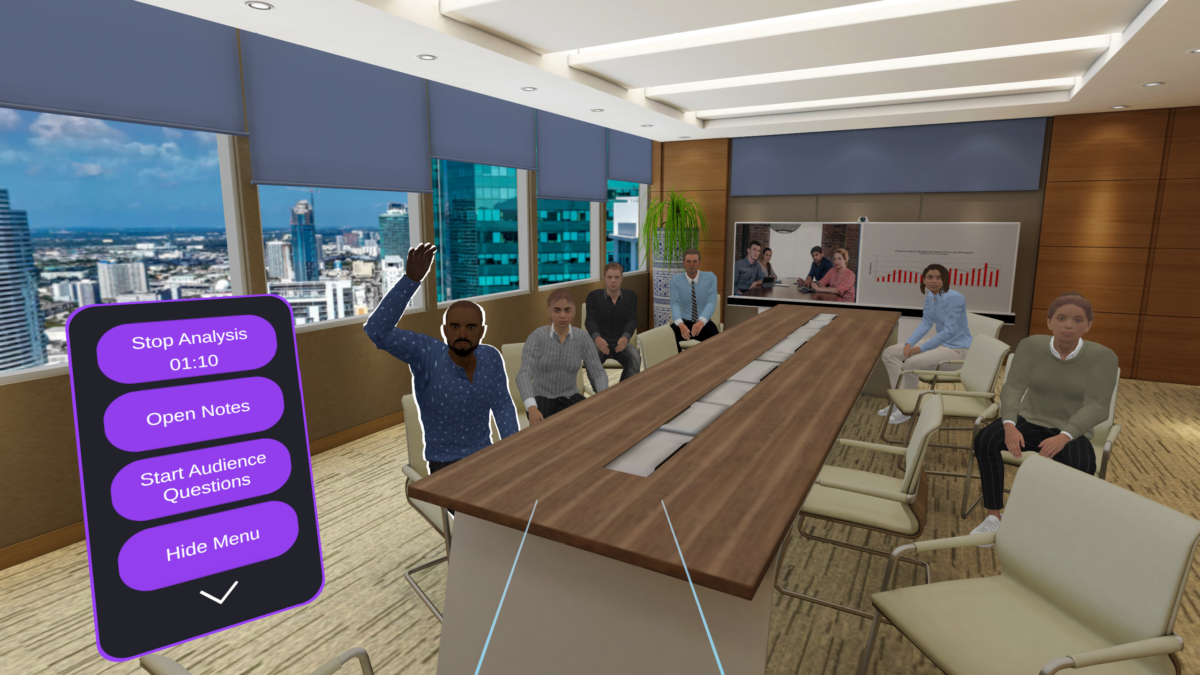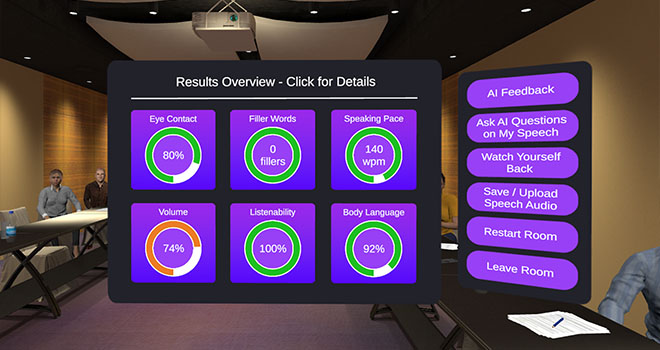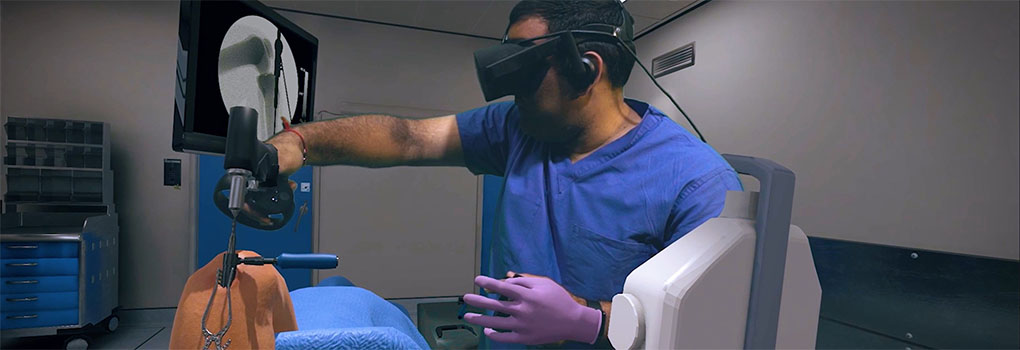Virtual Reality (VR) has become increasingly popular as a way to train people in a wide range of industries. Companies including BMW, Walmart, Verizon and Ford are training their employees in aspects such as design, presentation skills, empathy, customer service and engineering.
A whitepaper by Intel estimates that their first VR-based corporate training course has a potential 5-year ROI of 300%, with 94% of trainees wanting more VR-based courses.
In today’s training environment, there are multiple challenges that can be overcome by immersive learning:
- Changes in target audiences, budget, and skills needed to introduce new technologies
- Growing headcount and teams working remotely
- Growth in popularity of presenting information in a short, crisp and direct way
In this article, we’ll explain how training in VR can address these challenges, as well as other benefits of VR training, including increased memory retention, performing dangerous tasks in a risk-free environment, the ability to repeat exercises, isolation from distractions and detailed skills assessment.
1. Risk-free training environments that build real-world confidence
VR provides a safe and realistic way to train, without the risk of injury or costly damage to expensive equipment. There are some immediate use cases which highlight this:
- Doctors can practice difficult surgeries they might not have performed before
- Workers can learn how to operate a crane without needing to actually be inside one
- Firefighters can simulate dealing with fires without putting their lives at risk
- Employees can learn how to deal with active shooters or robbery
- Staff can practice working with a new food production machine without the possibility of destroying the equipment
Through immersive VR, trainees get to safely experience situations that may normally be unsafe. And perhaps most importantly, they can practice in these virtual situations as often as needed to feel prepared and confident.
Using interactive training techniques that manuals and videos can’t provide, employees can experience, make mistakes and learn through repetition, which is often impossible in the real-world when it puts the organisation at risk.

A demo by Flaim System showing how VR can be using to train firefighters in VR.
2. Remote training that saves time, money, and the environment
Traditional instructor-led training often requires employees to gather at a designated location, resulting in employees having to commute. However, immersive learning through VR eliminates these drawbacks by allowing employees to undergo training within their office or even from the comfort of their homes, without the need for travel.
By embracing VR for training, organizations can save significant time and costs associated with employee travel. Employees no longer have to allocate time for commuting or being away from the office, enabling them to dedicate more hours to productive work.

Moreover, the use of VR in remote training aligns with the current trend of decentralized workplaces. With the availability of video calls and VR collaboration tools, individuals can effectively collaborate across vast distances.
VR headsets are also becoming more affordable, allowing organizations to purchase them for training purposes and subsequently implement remote training initiatives. Trainees can easily download and access training materials from anywhere, eliminating geographical barriers and enabling seamless participation in training programs.
In addition to the advantages of convenience and cost savings, remote VR training also brings significant environmental benefits. By eliminating the need for travel, organizations can reduce their carbon footprint and contribute to sustainability efforts. This eco-friendly approach aligns with the growing awareness and commitment to environmental responsibility in today’s society.
3. Boosted memory retention and recall
Higher engagement rates typically lead to higher retention rates and recall. If learners pay attention to what they’re learning, they’ll remember it more effectively.
Research suggests that memory retention after a VR experience is higher than after viewing video or text-based learning materials. A study in the Education Psychology Review explains how memory is made stronger with increased multi-sensory and emotional input – something that VR does well.
An example highlighting this gave half the participants a 360-degree VR video of a motorcycle ride to watch, while the other half watched a regular 2D video. A memory test 48 hours later showed that the VR group performed twice as well as the video group in the memory recollection test.
4. Repeatable and controlled exposure to stressful situations
Another unique benefit of VR training lies in its ability to replicate high-stress scenarios safely, allowing participants to practice skills and emotional responses in challenging contexts. Research shows that VR’s immersive nature can mirror our physiological responses in real-world stress-inducing situations, which is why VR is widely used in therapeutic fields to treat phobias and PTSD. In a training context, employees can repeatedly face high-stakes situations until they build confidence and resilience, an opportunity not feasible in traditional training formats.
Furthermore, integrating Generative-AI in VR enables hyper-realistic and tailored practice, where learners interact with avatars that engage in real-time, conversational roleplays. VirtualSpeech’s AI-powered avatars provide scenarios that replicate real-world interactions, such as a leader delivering difficult feedback or disappointing news about a promotion. For healthcare professionals, these roleplays could include high-empathy situations like communicating a challenging diagnosis to a patient.
This level of personalization and adaptability enhances the practical application of skills, ensuring participants feel prepared and equipped to handle complex, emotionally charged situations in the workplace.
5. Highly engaging training at scale
VR provides a way to train large numbers of employees in an effective way. Previously, organisation had to choose between less effective but scalable solutions (i.e. videos and online courses) and effective but expensive solutions (i.e. instructor-led and on-the-job training).
Moreover, the integration of data analytics within VR training provides valuable insights for Learning and Development (L&D) teams. It allows them to track and measure individual employee progress, completion rates, and performance during training sessions. Additionally, organizations can assess the return on investment (ROI) of their VR training initiatives.
VirtualSpeech, for instance, provides a comprehensive admin dashboard that facilitates these analytical capabilities.
6. Distraction-free learning environment
Keeping people motivated during both online and in-person training sessions can be a challenge. The constant temptation of checking your mobile phone and other distractions cause learners to lose focus. With research suggesting our attention spans are shrinking, a method of training in a distraction free environment is exciting.
When employees put on a VR headset, the experience captures the learner’s full attention through both visual and audio stimuli – users are fully immersed in the virtual environment where they can learn distraction free.
The isolation from distraction helps to increase learner engagement, leading to higher retention rates and overall, less time spent training.
7. Improve skills faster through experiential learning
As highlighted in a whitepaper by Todd Maddox which looks into the science behind VR enhanced training, “compared to traditional learning tools… virtual reality speeds the development of mastery and expertise through repeated experiential learning that broadly engages multiple learning systems in the brain in synchrony and is scalable.
Learning by doing has long been established as one of the most effective ways to improve a skill. When you perform the task over and over again in a realistic setting, you improve that skill much faster than if you just read or watched a video about it.
According to the cone of learning by Edgar Dale, after two weeks, the human brain tends to remember 10 percent of what is reads, 20 percent of what is heard, but 90 percent of what it does or simulates.

Practice various soft skills in VR with the VirtualSpeech app.
Another study carried out by the National Training Laboratory revealed that retention rates for hands on learning was 75 percent, whereas for lecture style learning, only 5 percent.
Importantly for calculating ROI for a VR project, VR enables experiential learning. Some studies demonstrate that a 15 minutes VR experience can produce the same amount of learning as from a 1.5 hours documentary.
Furthermore, some of our clients have reported a 20% skill improvement after just 10 minutes of VR training.
In addition, the jump from reading a manual and watching others do a task, to actually getting to perform that task well, is bigger and more error prone than the one between a VR experience of practicing that task and doing it for real.
8. Skills assessment and data-driven insights
How do you assess an employee’s role for a new position in the organisation? How do you evaluate performance based on quantifiable data?
Humans introduce a huge amount of variation during assessment of an employees or candidates’ performance. They can introduce bias without knowing it, questions can be interpreted differently depending on the person or there might not be sufficient data to properly assess the person. In addition, people might lie about their qualifications and experience, adding to additional variation.
VR and immersive learning exercises can be used to assess whether employees are best suited to a given role or set of roles, as well as to better understand how candidates and managers would behave in real-world scenarios, if hired.
- Read more about data-driven insights for VR in our whitepaper
It’s important to think about the VR training objectives to ensure you capture the right data points that will give the business actionable insights.

An example of speech analysis scores in the VirtualSpeech app.
In contrast with traditional methods, assessment in VR captures far more comprehensive data that can be analysed. Subjective ratings of confidence, satisfaction and engagement can be obtained. L&D teams can determine if learning has actually occurred and challenged the learner.
These can be combined with data from eye gaze, heat maps and more, providing insights into the attentional processes and engagement of the learner. This data can be used to iterate towards an optimal training solution.
